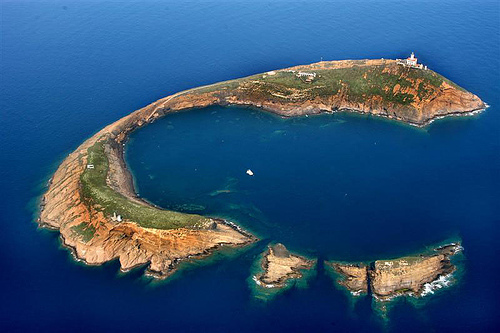Columbretes Islands
Posted on July 14, 2021 • 3 minutes • 515 words • Other languages: Espanol
Let’s talk about the Columbretes Islands , a little piece of paradise in the Mediterranean! These islands, which are like hidden gems, are about 30 miles off the coast of Castelló, that’s about 56 km. They’re a bunch of islets and rocks grouped into four clusters, each with its main island: l’Illa Grossa, la Ferrera, la Foradada, and el Carallot. And hey, l’Illa Grossa is the only one with people living on it.
These islands are on a seabed that’s about 80 meters deep, and they’re the best example of volcanism we’ve got. The star is l’Illa Grossa, which has a bunch of craters one after the other, and el Carallot, which with its 32 meters of height above the sea, is like a reminder of what was once the central chimney of a volcano. And around these islands, there’s a Marine Reserve that covers about 5,543 hectares.
As for the critters, there are a lot of seabirds that nest here. The Audouin’s gull, the Balearic shearwater, the Eleonora’s falcon, and the European shag, they’ve all made these islands their home in the Valencian Community. And not just birds, there are also a lot of endemic insects. And to top it off, there’s a species of lizard that’s only found here.
And if you go underwater, it’s another world. The seabed is a labyrinth of rocks, banks, and shallows, where many overexploited species find refuge. There’s everything from red corals to an algae called Laminaria redriguezi, which is very rare in our sea.
As for the plants, they manage to bloom and spread their seeds quickly with the little rain there is. Between March and early June, depending on how much it rains, the islands are filled with colors and smells. There are two plants that are only found here: the Columbretes’ sea rocket and the tree medick. The most common plant is the shrubby sea-blite, which covers most of l’Illa Grossa. There are also others like the sea carrot, the rock samphire, the boxthorn, and the paternoster pea.
If you want to visit l’Illa Grossa, you have to go in small groups and always with a guide. The walk lasts between one and two hours, and takes you from the stairs of the port to the lighthouse, passing by the Visitor Center. There you can see an exhibition about human history and fishing in the Columbretes. During the walk, you can see a lot of birds and seabirds, lizards, insects, and the most representative plants of the island, all this in an impressive volcanic landscape.
And if you want to know more, you can visit the Information Center of the Natural Reserve of the Columbretes Islands, which is located in the Planetarium of Castelló. There they have an exhibition about the islands and fishing. You can do the tour on your own, with the voice of a fisherman as a guide. They also have a projection and conference room where you can watch videos and talks. So now you know, if you want a little piece of paradise, the Columbretes are waiting for you!
 Hotel Sancho III
Hotel Sancho III
